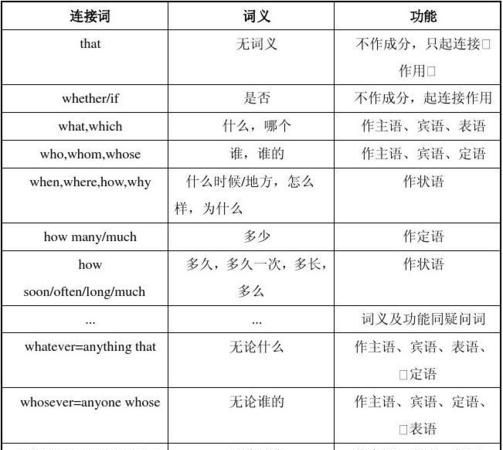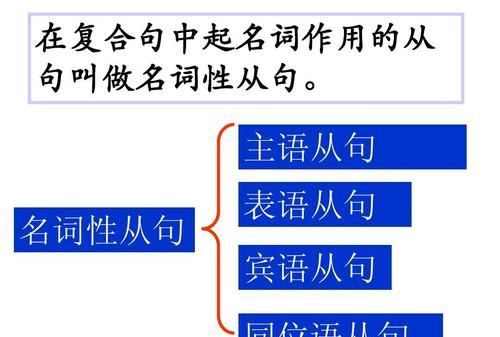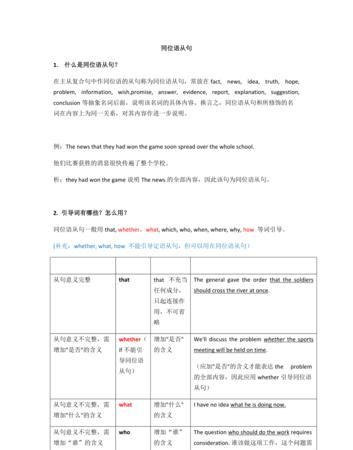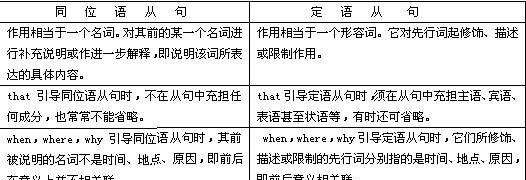本文目录
同位语从句是什么能举些个例子
同位语从句
1、概述
用作同位语的从句叫同位语从句.它一般跟在抽象名词fact,idea,news,hope,belief,thought,truth,doubt,suggestion,warning,instruction,reason,information,question等之后,对这些名词进行说明或解释.引导同位语从句的词除连词that,whether外,还有关系代词what,which,who,以及关系副词how,when,where,why等.It is a fact that smoking is a danger to health.吸烟危害健康,这是事实.I have no idea what you mean.我一点儿也不明白你的意思.He made the suggestion that we go by train.他建议我们坐火车去.There is no doubt that he is guilty.毫无疑问,他是有罪的.
2、由从属连词that,whether引导的同位语从句.Information has been put forward that more middle school graduates will be admitted into universities.有消息透露,大学将招收更多的中学毕业生.The fact that we lack enough phones needs to be considered.我们缺少足够的电话这一事实需要加以考虑.The idea that computers can recognize human voices surprises many people.计算机能够识别人的声音的想法使许多人感到惊奇.I didn't receive the news that the meeting had been put off.我没有听到会议被推迟的消息.
3、由关系代词引导的同位语从句.The question who should be the first has not been settled.谁应该是第一名的问题还没有定下来.You can have no idea what he said.你根本想不到他说了些什么.
4、由关系副词引导的同位语从句.I have no idea when he will be back.我不知道他什么时候回来.They usually write exact instructions how the music is to be played.他们通常为如何演奏乐曲写出精确的说明.


什么是同位语从句
同位语从句是解释名词的具体含义的一类句子。这些被同位语从句修饰的名词往往是抽象的名词:idea, suggestion, news, truth,fact等。如:I have an idea that we go to the beach.我有一个主意我们去海滩。这里面主意的具体内容就是“我们去海滩”。既“主意”=“我们去海滩”。而如果用定语从句的话,从句只是修饰形容名词,并未解释名词的具体内容,如:I have an idea that I think is very good.我有一个我认为非常好的主意。主意内容不等于“我认为非常好”。所以这个是定语从句,只是形容什么样的主意。
同位语从句的例子:
Tom's suggestion that the company give up the plan sounds good.
It is a truth that the earth goes around the sun.
同位语从句和主语从句、宾语从句、表语从句都叫做名词性从句。

英语同位语从句
在复合句中充当同位语的名词性从句称为同位语从句。
同位语定义:
当两个指同一人或事物的句子成分放在同等位置时,其中一个句子成分可用来说明或解释另一个句子成分,此时前者(起说明或解释作用的句子成分)就叫做后者(被说明或解释的句子成分)的同位语。如:
We have two children, a boy and a girl. 我们有两个孩子,一个男孩和一个女孩。(句中的a boy and a girl为two children的同位语)
同位语从句用法:
一、同位语从句在句中的位置
1.一般情况下同位语从句跟在某些名词(如news, idea, fact, promise, hope, message等)的后面,用以说明该名词所表达的具体内容。
2.有时同位语从句可以不紧跟在它所说明的名词后,而被别的词语隔开,在语法上叫做分隔式同位语从句。
二、同位语从句前名词的数
同位语从句前的名词通常用单数形式,并且往往带有限定词(word除外)加以修饰。
三、同位语从句连接词的选用
在英语中,引导同位语从句的词通常有连词(that, who, whether),连接副词(how, when, where)等。
注:在名词doubt“怀疑”后的同位语从句用whether连接;在no doubt“不怀疑”之后的同位语从句用that连接。
同位语从句:that
以下名词常用于以上句型:
advice, announcement, argument, belief, claim, conclusion, decision, evidence, explanation, fact, feeling, hope, idea, impression, information, knowledge, message, news, opinion, order, probability, promise, proposal, remark, reply, report, saying, statement, suggestion, thought, treat, warning, wish, word
同位语从句:whether
whether可以引导同位语从句,而定语从句不能用whether作为引导词。
同位语从句:what
what可以引导同位语从句,而定语从句不能用what作为引导词
同位语从句:how
how可以引导同位语从句,而定语从句不能用how作为引导词
同位语从句:who等
who, whom, which, when, where, why用来引导同位语从句
四、同位语从句的语气
在suggestion, advice, request, order等意为“建议;命令;要求”的名词后,同位语从句中的谓语动词通常用“should +动词原形”的虚拟语气结构,句中的should可以省略。
同位语从句与定语从句的用法区别

以上就是关于同位语从句的抽象名词有哪些 ,同位语从句怎么记住抽象名词的全部内容,以及同位语从句的抽象名词有哪些 的相关内容,希望能够帮到您。
